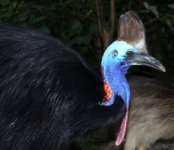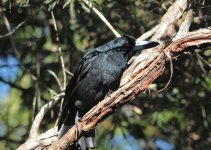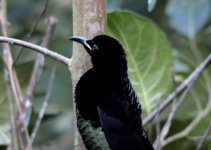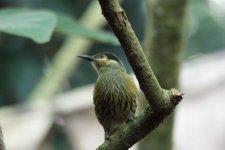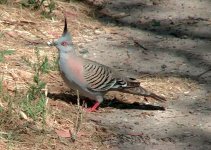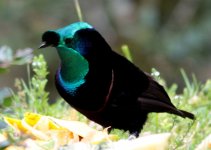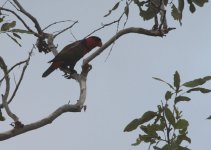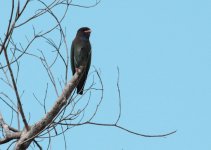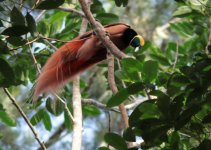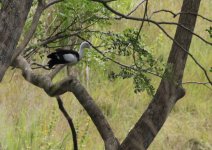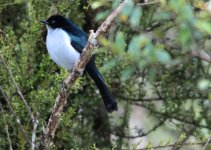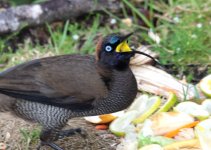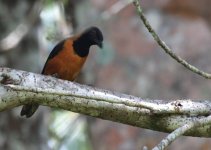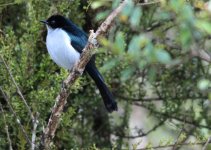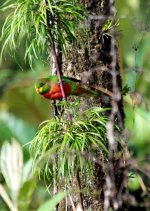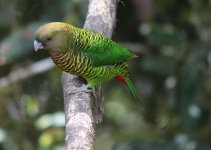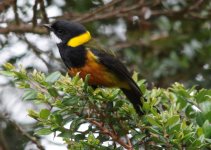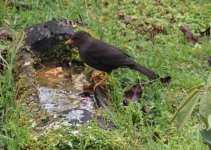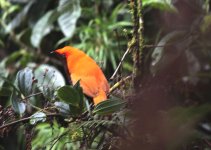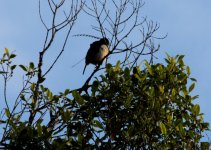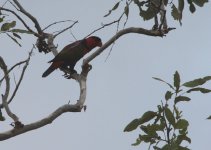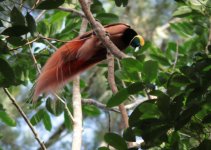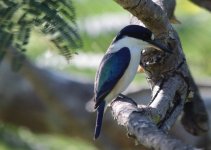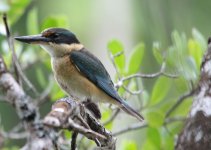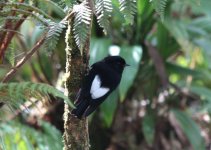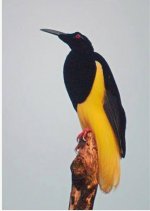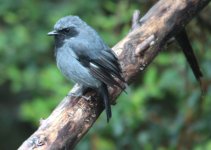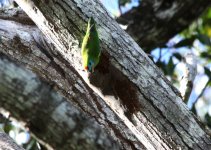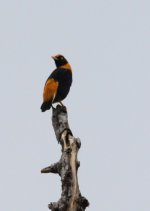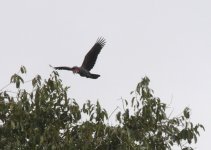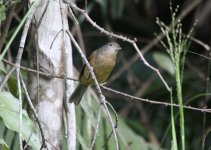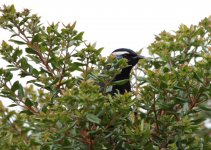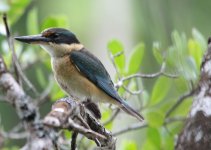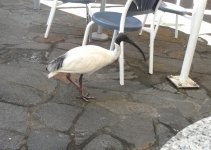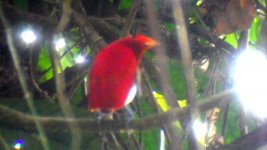Queensland and Papua New Guinea 3-28th May 12
Excuse the format. This is first trip report I’ve filed. I was posting quite a few photos to the Gallery from a recent trip to Queensland and New Guinea and it was suggested that I provide a report.
I haven’t recorded the sort of detail that others have as I decided to do this after the event, but as Papua New Guinea isn’t that well traveled I thought the information could be helpful to those planning a trip.
We flew to Brisbane on 3 May, spent 3 days in Kuranda (Cassowary House) and visited the local N Queensland birding spots and then had just over two week in PNG on an itinerary we put together with Sue Gregory (of Sicklebill Safaris). We ended with some relaxing bird watching at the Acacia Court Hotel in Cairns before flying back on 28th May.
In Port Moresby and Tabubil we used comfortable, western style hotels of a good standard Raintree Lodge (great value and very friendly) and Cloudlands (quite expensive but OK). In Kiunga we stayed twice at the Kiunga Guest House a small but very good locally run place. In the mountains we used Kumul Lodge, the lodge is made of local materials and situated an hour from Mt Hagen at an elevation of about 2600m but with lower and higher level birding available nearby (didn’t quite manage number of BoPs that you get at Tari but still got 8 here, missing two or three possibles). Kwatu Lodge was quite basic with pit toilets and bush showers and no electricity, where we needed to take our own beer and food with us (more on that later) but where else can you wake to a 12 wire Bird of Paradise in scope view waiting for you.
We arrived In Brisbane too late to do anything on our first night
but got off early on Day 2 to remind ourselves of some local birds with a walk along the river to the Botanic Gardens and then took a ride on the Cat to Hamilton and then back to the city. Even on largely non birding day we managed our first lifer of the trip “Bush Stone Curlew” two pairs in the Botanic Gardens; and saw some birds such as Australian Pelican, Australian Ibis, Silver Gull, Willie Wagtail, Australian Magpie, Blue-faced Honeyeater, Noisy Miner, Torresian Crow and Welcome Swallow that reminded us how good the birding in Queensland could be (this was our second trip).
Day 3 – Traveled from Brisbane to Cairns arriving in late morning and picked up our Car at the Airport, we got offered a free upgrade to 4 Wheel Drive, which proved useful for driving some of the mountain roads. We then drove up to Cassowary House to meet Sue and talk about our PNG itinerary.
Birding around Cassowary House and Black mountain Road was excellent. Highlights were our first Southern Cassowary (Male and two chicks), Double-eyed Fig Parrot, Yellow-spotted Honeyeater, Macleays Honeyeater, Bar-breasted Honeyeater, Pale Yellow Robin and Spectacled Monarch all new and other great birds like King Parrot, Shining and Lemon-bellied Flycatchers, Brown Gerygone, Common Bronzewing and Mistletoe Bird all within a mile of the house.
Then drove into Kuranda to pick up fish and chips and take them back to the House so we could have an early night. After we parked saw Rainbow Lorikeet, Blue Winged Kookaburra and Sulphur Crested Cockatoo.
Day 4 – Breakfast on the balcony, where we could see the feeders, still a little dark for photography but couldn’t resist trying for Hornbill (helmeted) Friarbird, MacLeay’s Honeyeater, Emerald Dove, Brush Turkey, Black Butcherbird and Musky Rat Kangaroo record shots. Over breakfast discussed with Sue and Phil places we could go and were given directions for possible Golden Bowerbird near Atherton. We decided to go for that via Tingaloo Creek Road and M Wetlands where there was a chance of a few birds we were after such as Squatter Pigeon and Black Throated Finch.
We started along the Tinaroo creek road, where we quickly saw White-breasted Wood Swallow, Black and Square Tailed Kite and Grey Goshawk. I think we should have then turned right before the tarmac road turned to a track (led eventually to Damburra Mountain Forest Road and through a national park). Anyway the birding was pretty good on the track, first we got a flock of Squatter Pigeons which was a target bird for the day, then at a little creek crossing we had a mixed flock of finches including Black Throated which we were told were pretty elusive, then in the thinner trees Pale headed Rosella and Forest Kingfisher showed well. In the forest we had Pied and White Eared Monarch and then Northern Fantail. When we emerged from the forest we headed towards Atherton but via some lakes and wetlands at our first stop we managed to get Logrunner and Chowchilla (another lifer for us near Lake Eacham) before taking a wrong turning and finding ourselves near some waterfalls outside Malanda and not on the right mountain road for the Golden Bowerbird. However there was a reserve with Tree Kangaroos to be looked for (later told by Sue that we were there at wrong time for them. Still we did get Bower’s Shrike Thrush, Grey Crowned Babbler, Spotted Catbird and a female Victoria’s Riflebird in the forest which were all new and in the scrub Atherton Scrubwren, Mountain Thornbill and Fern Wren again all lifers.
As we wanted to get back before it got dark we decided to go via the small wetlands near Atherton “Hasties Swamp” in hope of Cranes, unfortunately there were none to be seen but we did get Straw-necked Ibis, Plumed Whistling Duck, Masked Lapwing and Comb Crested Jacana – all nice birds.
Day 5 – short walk before breakfast saw us add Orange-legged Scrubfowl and the whole Cassowary family (Male, Female and 2 chicks) Missie is very impressive. Over breakfast we are given some advice by Phil on PNG and told some tales of Phil’s adventures there. He also advised us where to see Silver-eared Honeyeater in the Craft Market at Port Moresby (we didn’t need it as it turned out). Activity at the feeders was better today and we had both male and female Victoria Riflebirds, the usual Friarbird and Butcherbird, loads of Honeyeaters and Emerald Dove. While on the ground the Cassowaries were joined by Brush Turkeys.
Today we decided to bird Henry Hanson Drive (the road we should have turned down yesterday), then the Mareeba Wetlands (but closed for fumigation so we missed the Treecreeper) then Mount Malloy then Barron Falls on the way back.
On the Drive we came across a small river crossing and scrubby hillside area which proved excellent – firstly White-faced and Barred Cuckoo Shrikes, Double-barred Finch, Nutmeg Mannikin, Little Bronze Cuckoo (Gould’s?), Crested Pigeon and Striated Pardalote, Red-backed Fairy Wren and Sacred kingfisher.
Then in Mount Malloy by the Cemetery we found Great Bowerbird (the target lifer here) and then near the school as advised flocks of Red-winged Parrots, Pale Headed Rosella and Forest Kingfisher and a male Great Bowerbird which unfortunately disappeared into a Garden and I was forced to settle for photographing the female.
Enroute to Barron Falls we got an Emu and then in the forest found Fairy Gerygone, Eastern Yellow Robin and Rufous Throated Honeyeater.
Dinner in the revamped Kuranda Resort where steaks were $10 each and beer not expensive offered good value but no choice for those who don’t like steak.
Day 6 – Last words of advice from Phil and Sue before heading to the airport for our late morning flight to Port Moresby. Decided to leave some luggage at Cassowary House as on little planes luggage allowance is 15Kg and there isn’t a lot of leeway when you need to take Wellingtons, tripod, field guides and other birding paraphernalia.
Flight went smoothly. Thanks to advice from Sue we knew that we should be able to change some money to PNG K at Port Moresby Airport before clearing immigration and get a much better rate than in the UK or Australia (sure enough we were able to use a ATM before immigration and customs, but we were told that even if the ATM was out and the counter closed we would have been allowed to leave our values and go into the terminal to get card to pay for the entry visa K100 about £30. We then bought a local SIM card and some credit for my mobile phone which is much cheaper than using roaming services and actually had very good coverage in PNG.
The Raintree people we waiting for us after luggage collection and had us in the Hotel is very short time. When we arrived at Raintree or birding guide Daniel was waiting for us and gave us 30 minutes to get our gear sorted before taking us to PAU. The ponds at the Pacific Adventist University in Port Moresby, were an excellent introduction to New Guinea birding and we got two target species Fawn-breasted Bowerbird and Spotted Whistling Duck, as well as Pied Heron, Purple Swamphen, Magpie Goose, Pacific Golden Plover in and around the first ponds. In the far trees we got our first PNG fairy wren a White Shouldered and some Singing Starlings.
A sharp downpour had us sheltering under trees but we still managed a Yellow Faced Myna. NG Helmeted Friarbird and Pheasant Coucal. When the rain finally eased we headed back to the main ponds and started to look for pigeons and doves coming in. The first group was Orange fronted Fruit doves which landed on the trees opposite to give good scope views, then over went Torresian Imperial Pigeon and finally my favourite of the three Pink Spotted Fruit Doves which also landed and gave good views.
On the walk back to the car we managed another lifer (most things were at this early stage) male and female Electus Parrots. It was then back to the hotel via a lot of heavy traffic made worse it seemed by the heavy rain earlier.
Glad to say the beer and food at the hotel was excellent and the air-conditioning, extremely pleasant after the high humidity outside.
Day 7 – early start breakfast of fruit and really good pancakes at 5am and on our way by 5.20 to get up to the Sogeri Plateau by first light. Our first stop was a few miles before Varirata National Park this is an area of savanna woodland on the plateau above Port Moresby famous for its Raggiana BoP lek-trees and forest trails.
More to follow
Excuse the format. This is first trip report I’ve filed. I was posting quite a few photos to the Gallery from a recent trip to Queensland and New Guinea and it was suggested that I provide a report.
I haven’t recorded the sort of detail that others have as I decided to do this after the event, but as Papua New Guinea isn’t that well traveled I thought the information could be helpful to those planning a trip.
We flew to Brisbane on 3 May, spent 3 days in Kuranda (Cassowary House) and visited the local N Queensland birding spots and then had just over two week in PNG on an itinerary we put together with Sue Gregory (of Sicklebill Safaris). We ended with some relaxing bird watching at the Acacia Court Hotel in Cairns before flying back on 28th May.
In Port Moresby and Tabubil we used comfortable, western style hotels of a good standard Raintree Lodge (great value and very friendly) and Cloudlands (quite expensive but OK). In Kiunga we stayed twice at the Kiunga Guest House a small but very good locally run place. In the mountains we used Kumul Lodge, the lodge is made of local materials and situated an hour from Mt Hagen at an elevation of about 2600m but with lower and higher level birding available nearby (didn’t quite manage number of BoPs that you get at Tari but still got 8 here, missing two or three possibles). Kwatu Lodge was quite basic with pit toilets and bush showers and no electricity, where we needed to take our own beer and food with us (more on that later) but where else can you wake to a 12 wire Bird of Paradise in scope view waiting for you.
We arrived In Brisbane too late to do anything on our first night
but got off early on Day 2 to remind ourselves of some local birds with a walk along the river to the Botanic Gardens and then took a ride on the Cat to Hamilton and then back to the city. Even on largely non birding day we managed our first lifer of the trip “Bush Stone Curlew” two pairs in the Botanic Gardens; and saw some birds such as Australian Pelican, Australian Ibis, Silver Gull, Willie Wagtail, Australian Magpie, Blue-faced Honeyeater, Noisy Miner, Torresian Crow and Welcome Swallow that reminded us how good the birding in Queensland could be (this was our second trip).
Day 3 – Traveled from Brisbane to Cairns arriving in late morning and picked up our Car at the Airport, we got offered a free upgrade to 4 Wheel Drive, which proved useful for driving some of the mountain roads. We then drove up to Cassowary House to meet Sue and talk about our PNG itinerary.
Birding around Cassowary House and Black mountain Road was excellent. Highlights were our first Southern Cassowary (Male and two chicks), Double-eyed Fig Parrot, Yellow-spotted Honeyeater, Macleays Honeyeater, Bar-breasted Honeyeater, Pale Yellow Robin and Spectacled Monarch all new and other great birds like King Parrot, Shining and Lemon-bellied Flycatchers, Brown Gerygone, Common Bronzewing and Mistletoe Bird all within a mile of the house.
Then drove into Kuranda to pick up fish and chips and take them back to the House so we could have an early night. After we parked saw Rainbow Lorikeet, Blue Winged Kookaburra and Sulphur Crested Cockatoo.
Day 4 – Breakfast on the balcony, where we could see the feeders, still a little dark for photography but couldn’t resist trying for Hornbill (helmeted) Friarbird, MacLeay’s Honeyeater, Emerald Dove, Brush Turkey, Black Butcherbird and Musky Rat Kangaroo record shots. Over breakfast discussed with Sue and Phil places we could go and were given directions for possible Golden Bowerbird near Atherton. We decided to go for that via Tingaloo Creek Road and M Wetlands where there was a chance of a few birds we were after such as Squatter Pigeon and Black Throated Finch.
We started along the Tinaroo creek road, where we quickly saw White-breasted Wood Swallow, Black and Square Tailed Kite and Grey Goshawk. I think we should have then turned right before the tarmac road turned to a track (led eventually to Damburra Mountain Forest Road and through a national park). Anyway the birding was pretty good on the track, first we got a flock of Squatter Pigeons which was a target bird for the day, then at a little creek crossing we had a mixed flock of finches including Black Throated which we were told were pretty elusive, then in the thinner trees Pale headed Rosella and Forest Kingfisher showed well. In the forest we had Pied and White Eared Monarch and then Northern Fantail. When we emerged from the forest we headed towards Atherton but via some lakes and wetlands at our first stop we managed to get Logrunner and Chowchilla (another lifer for us near Lake Eacham) before taking a wrong turning and finding ourselves near some waterfalls outside Malanda and not on the right mountain road for the Golden Bowerbird. However there was a reserve with Tree Kangaroos to be looked for (later told by Sue that we were there at wrong time for them. Still we did get Bower’s Shrike Thrush, Grey Crowned Babbler, Spotted Catbird and a female Victoria’s Riflebird in the forest which were all new and in the scrub Atherton Scrubwren, Mountain Thornbill and Fern Wren again all lifers.
As we wanted to get back before it got dark we decided to go via the small wetlands near Atherton “Hasties Swamp” in hope of Cranes, unfortunately there were none to be seen but we did get Straw-necked Ibis, Plumed Whistling Duck, Masked Lapwing and Comb Crested Jacana – all nice birds.
Day 5 – short walk before breakfast saw us add Orange-legged Scrubfowl and the whole Cassowary family (Male, Female and 2 chicks) Missie is very impressive. Over breakfast we are given some advice by Phil on PNG and told some tales of Phil’s adventures there. He also advised us where to see Silver-eared Honeyeater in the Craft Market at Port Moresby (we didn’t need it as it turned out). Activity at the feeders was better today and we had both male and female Victoria Riflebirds, the usual Friarbird and Butcherbird, loads of Honeyeaters and Emerald Dove. While on the ground the Cassowaries were joined by Brush Turkeys.
Today we decided to bird Henry Hanson Drive (the road we should have turned down yesterday), then the Mareeba Wetlands (but closed for fumigation so we missed the Treecreeper) then Mount Malloy then Barron Falls on the way back.
On the Drive we came across a small river crossing and scrubby hillside area which proved excellent – firstly White-faced and Barred Cuckoo Shrikes, Double-barred Finch, Nutmeg Mannikin, Little Bronze Cuckoo (Gould’s?), Crested Pigeon and Striated Pardalote, Red-backed Fairy Wren and Sacred kingfisher.
Then in Mount Malloy by the Cemetery we found Great Bowerbird (the target lifer here) and then near the school as advised flocks of Red-winged Parrots, Pale Headed Rosella and Forest Kingfisher and a male Great Bowerbird which unfortunately disappeared into a Garden and I was forced to settle for photographing the female.
Enroute to Barron Falls we got an Emu and then in the forest found Fairy Gerygone, Eastern Yellow Robin and Rufous Throated Honeyeater.
Dinner in the revamped Kuranda Resort where steaks were $10 each and beer not expensive offered good value but no choice for those who don’t like steak.
Day 6 – Last words of advice from Phil and Sue before heading to the airport for our late morning flight to Port Moresby. Decided to leave some luggage at Cassowary House as on little planes luggage allowance is 15Kg and there isn’t a lot of leeway when you need to take Wellingtons, tripod, field guides and other birding paraphernalia.
Flight went smoothly. Thanks to advice from Sue we knew that we should be able to change some money to PNG K at Port Moresby Airport before clearing immigration and get a much better rate than in the UK or Australia (sure enough we were able to use a ATM before immigration and customs, but we were told that even if the ATM was out and the counter closed we would have been allowed to leave our values and go into the terminal to get card to pay for the entry visa K100 about £30. We then bought a local SIM card and some credit for my mobile phone which is much cheaper than using roaming services and actually had very good coverage in PNG.
The Raintree people we waiting for us after luggage collection and had us in the Hotel is very short time. When we arrived at Raintree or birding guide Daniel was waiting for us and gave us 30 minutes to get our gear sorted before taking us to PAU. The ponds at the Pacific Adventist University in Port Moresby, were an excellent introduction to New Guinea birding and we got two target species Fawn-breasted Bowerbird and Spotted Whistling Duck, as well as Pied Heron, Purple Swamphen, Magpie Goose, Pacific Golden Plover in and around the first ponds. In the far trees we got our first PNG fairy wren a White Shouldered and some Singing Starlings.
A sharp downpour had us sheltering under trees but we still managed a Yellow Faced Myna. NG Helmeted Friarbird and Pheasant Coucal. When the rain finally eased we headed back to the main ponds and started to look for pigeons and doves coming in. The first group was Orange fronted Fruit doves which landed on the trees opposite to give good scope views, then over went Torresian Imperial Pigeon and finally my favourite of the three Pink Spotted Fruit Doves which also landed and gave good views.
On the walk back to the car we managed another lifer (most things were at this early stage) male and female Electus Parrots. It was then back to the hotel via a lot of heavy traffic made worse it seemed by the heavy rain earlier.
Glad to say the beer and food at the hotel was excellent and the air-conditioning, extremely pleasant after the high humidity outside.
Day 7 – early start breakfast of fruit and really good pancakes at 5am and on our way by 5.20 to get up to the Sogeri Plateau by first light. Our first stop was a few miles before Varirata National Park this is an area of savanna woodland on the plateau above Port Moresby famous for its Raggiana BoP lek-trees and forest trails.
More to follow




